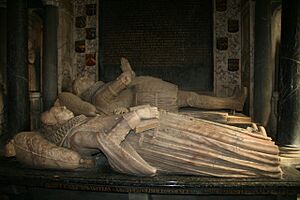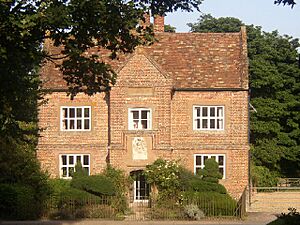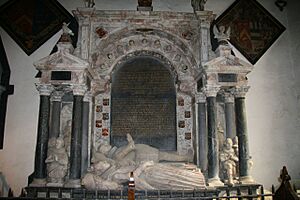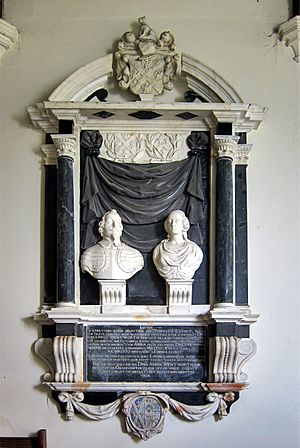Stephen Soame facts for kids
Sir Stephen Soame (born around 1540 – died May 23, 1619) was an important English merchant, a person who owned a lot of land, and a politician. He was a member of the House of Commons in 1601. He also served as the Lord Mayor of London from 1598 to 1599.
Contents
Stephen Soame's Life and Work
Stephen Soame was born into a family from Norfolk and Suffolk. His father, Thomas Soame, owned land in several places. Stephen was the second son. One of his younger brothers, Robert Soame, became the head of Peterhouse college and a leader at the University of Cambridge.
Stephen started his career as an apprentice in London with the Worshipful Company of Girdlers. This was a group for people who made belts and girdles. In the 1570s, he married Anne Stone, whose father was a Haberdasher (someone who sold small sewing items).
Stephen's main business was trading cloth. He worked a lot with the Eastland Company, which traded with countries around the Baltic Sea. In 1589, he became a Sheriff of London, a high-ranking official. In the same year, he became an alderman for Cheap ward in London, a position he held until he died.
In 1598, Stephen was chosen to be the Master of the Girdlers' Company. However, he was also chosen to be Lord Mayor of London that year. There was a problem because the Girdlers' Company was not one of the "twelve great Companies" that usually provided the Lord Mayor. So, Stephen had to join the Worshipful Company of Grocers (who traded in spices and other goods) to become Mayor. This made the Girdlers' Company very upset, and they even removed his family crest from their hall!
As Lord Mayor, Stephen Soame led the first meeting where merchants talked about starting the East India Company. This company became very famous for trading with India. He was also involved in other big trading groups like the Levant Company (trading with the Middle East) and the Spanish Company. His will (his last wishes) shows he had invested a lot of money in these trading ventures. He was also the Mayor of the Staple in London for almost 20 years, which meant he was in charge of a market for wool and other goods.
Stephen was knighted in April 1599, which meant he became "Sir Stephen." In 1601, he was elected a Member of Parliament for the City of London. He also served as a supervisor for hospitals until his death.
Stephen Soame's Special Projects
Sir Stephen built a large house in Little Thurlow, where he lived and later died. Sadly, it burned down in 1809, but old drawings show it was a grand mansion with many windows. He also had a home in London.
Sir Stephen was very generous and gave a lot to charity. He helped fix the big north window of Old St Paul's Cathedral and also paid to restore the ceiling of Grocers' Hall. In his will, he made sure that food would be given regularly to poor people and prisoners in London.
One of his most important projects was building a free school in Little Thurlow. He made sure there was money to pay a teacher and an assistant. Children there would learn English, Latin, and math to prepare them for university. He also built almshouses for eight or nine poor single men and women over 64 years old. These people received a small pension to help them live.
Lands and Estates
Sir Stephen owned many lands and estates. The school and almshouses he built were supported by money from his manor in Carlton, Cambridgeshire. He bought many other manors, like Little Thurlow, Cowlinge, and Hundon in Suffolk. These lands provided him with income.
He also owned lands in other counties like Essex, Cambridgeshire, Hertfordshire, and Kent. For example, he bought the manor of Brickendonbury in Hertfordshire for a large sum of money. These land holdings show how wealthy and influential he was.
Death and Memorial
Sir Stephen Soame died at his home in Little Thurlow on May 23, 1619, when he was 76 years old. He was buried there about a month later. His will, which was very detailed, was approved in January 1620.
His monument in the church at Little Thurlow is very grand. It has life-sized statues of Sir Stephen and Dame Anne carved from white marble. They are shown lying down, as if resting. The monument has a long inscription that tells about his life. It was made by a sculptor named Gerard Johnson and was paid for by Dame Anne. She also had a new part of the church built to hold the monument.
The monument is decorated with angels and family crests. It's a beautiful and detailed piece of art that shows how important Sir Stephen was.
Sir Stephen's Family
Sir Stephen and Anne Stone had many children. Their children's names and who they married are listed in old family records and on the monument:
- William Soame, who married Bridget Barnham.
- Stephen Soame, who married Elizabeth Playter.
- Thomas Soame, who became a Sheriff and Member of Parliament for London, married Joan Freeman.
- Nicholas Soame, who died when he was a baby.
- John Soame, who married Mary Perient.
- Matthew Soame, who died at age 21 without children.
- Marcy Soame, who married Sir Calthrop Parker.
- Mary Soame, who died when she was a baby.
- Jane Soame, who married Sir Nathaniel Barnardiston.
- Anne Soame, who married Sir John Wentworth.
- Judith Soame, who married Sir Francis Anderson.
Dame Anne, Sir Stephen's wife, was described as wise and religious. She and her sons helped build the new part of the church and put up the monument after Sir Stephen died. She lived for over three years as a widow and saw 22 grandchildren before she passed away on August 20, 1622. She is buried with her husband.





